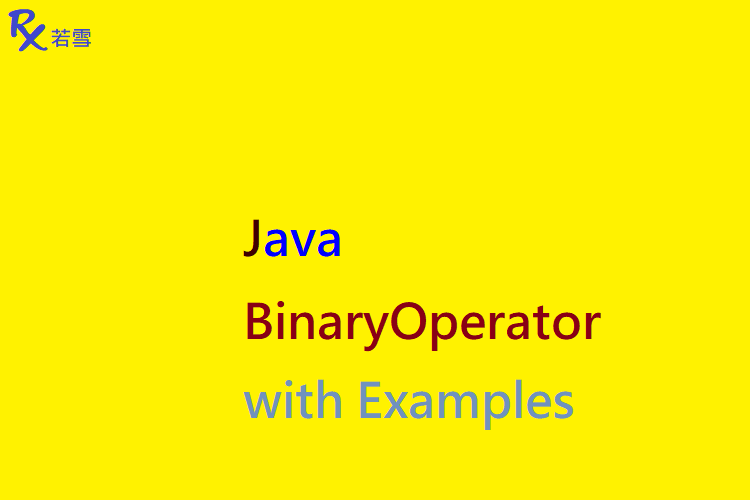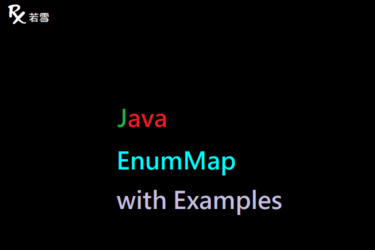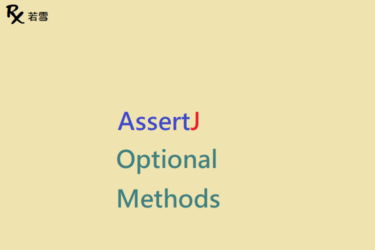Table of Contents
ToggleBinaryOperator in Java with Examples
只有一個抽象方法的接口,定義了 apply 方法,可以在一個元素上測試或應用一些操作,常用於物件轉換或數字運算,例如:取得字串長度、數字加減乘除運算,取代傳統實作接口的方法,讓程式碼更加簡潔和易讀, BinaryOperator in Java 本篇增加了範例,並透過單元測試來驗證產出結果。
@FunctionalInterface
public interface BinaryOperator<T> extends BiFunction<T,T,T> {
public static <T> BinaryOperator<T> minBy(Comparator<? super T> comparator) {
Objects.requireNonNull(comparator);
return (a, b) -> comparator.compare(a, b) <= 0 ? a : b;
}
public static <T> BinaryOperator<T> maxBy(Comparator<? super T> comparator) {
Objects.requireNonNull(comparator);
return (a, b) -> comparator.compare(a, b) >= 0 ? a : b;
}
}
檔案目錄
./
+- src
+- test
| +- org
| +- ruoxue
| +- java_147
| +- functional
| +- binaryoperator
| +- BinaryOperatorWithExamplesTest.java
單元測試
BinaryOperator Java 提供 apply 、 andThen 條件或組合成鏈式判斷等操作 BinaryOperator 。
Food
建立 Food 類別,覆寫 equals 、 hashCode ,定義屬性和方法,用來建立一個物件。
@NoArgsConstructor
@Getter
@Setter
@Builder
public static class Food {
private String name;
private double quantity;
private int type;
public Food(String name, double quantity, int type) {
this.name = name;
this.quantity = quantity;
this.type = type;
}
public String toString() {
ToStringBuilder builder = new ToStringBuilder(this, ToStringStyle.JSON_STYLE);
builder.appendSuper(super.toString());
builder.append("name", name);
builder.append("quantity", quantity);
builder.append("type", type);
return builder.toString();
}
public boolean equals(Object object) {
if (!(object instanceof Food)) {
return false;
}
if (this == object) {
return true;
}
Food other = (Food) object;
return new EqualsBuilder().append(getName(), other.getName()).isEquals();
}
public int hashCode() {
return new HashCodeBuilder().append(getName()).toHashCode();
}
} apply
BinaryOperator Java 建立 BinaryOperator 物件,傳入 2 個參數,執行程式邏輯,傳回物件。
@Test
public void apply() {
BinaryOperator<Food> merge = (o, o1) -> {
Food result = new Food();
result.setName(o.name.concat(o1.name));
result.setQuantity(o.quantity + o1.quantity);
result.setType(o.type + o1.type);
return result;
};
Food food = new Food("Bacon", 1, 1);
Food food2 = new Food("Ham", 2, 1);
Food result = merge.apply(food, food2);
System.out.println(result);
assertEquals("BaconHam", result.getName());
Food food3 = new Food("Pork", 3, 1);
result = merge.apply(food2, food3);
System.out.println(result);
assertEquals(5d, result.getQuantity(), 2);
}{"name":"BaconHam","quantity":3.0,"type":2}
{"name":"HamPork","quantity":5.0,"type":2}andThen
BinaryOperator Java 建立 2 個 BinaryOperator 物件,傳入 1 個參數,使用 andThen 組合執行程式邏輯,傳回物件,其中若有例外拋出,將會中斷執行。
@Test
public void andThen() {
BinaryOperator<Food> concat = (o, o1) -> {
o.setName(o.name.concat(o1.name));
return o;
};
Function<Food, Integer> multiply = o -> o.name.length() * 2;
Food food = new Food("Bacon", 1, 1);
Food food2 = new Food("Ham", 2, 1);
int result = concat.andThen(multiply).apply(food, food2);
System.out.println(result);
assertEquals(16, result);
Food food3 = new Food("Pork", 3, 1);
result = concat.andThen(multiply).apply(food2, food3);
System.out.println(result);
assertEquals(14, result);
}16
14andThenThrowException
BinaryOperator Java 建立 BinaryOperator 物件,傳入參數 null ,會拋出例外 。
@Test(expected = NullPointerException.class)
public void andThenThrowException() {
BinaryOperator<Food> ret = (o, o2) -> o2;
BiFunction<Food, Food, Food> biFunction = ret.andThen(null);
assertNotNull(biFunction);
}
java.lang.NullPointerException
at java.util.Objects.requireNonNull(Objects.java:203)
at java.util.function.BiFunction.andThen(BiFunction.java:69)
at org.ruoxue.java_147.functional.binaryoperator.BinaryOperatorWithExamplesTest.andThenThrowException(BinaryOperatorWithExamplesTest.java:106)
maxBy
Java BinaryOperator 建立 BinaryOperator 物件,傳入 2 個參數,比對後傳回最大值。
@Test
public void maxBy() {
BinaryOperator<Food> maxBy = BinaryOperator.maxBy(Comparator.comparingDouble(Food::getQuantity));
Food food = new Food("Bacon", 1, 1);
Food food2 = new Food("Ham", 2, 1);
Food result = maxBy.apply(food, food2);
System.out.println(result);
assertEquals(food2, result);
Food food3 = new Food("Port", 3, 1);
result = maxBy.apply(food2, food3);
System.out.println(result);
assertEquals(food3, result);
}{"name":"Ham","quantity":2.0,"type":1}
{"name":"Port","quantity":3.0,"type":1}minBy
Java BinaryOperator 建立 BinaryOperator 物件,傳入 2 個參數,比對後傳回最小值。
@Test
public void minBy() {
BinaryOperator<Food> minBy = BinaryOperator.minBy(Comparator.comparing(Food::getQuantity));
Food food = new Food("Bacon", 1, 1);
Food food2 = new Food("Ham", 2, 1);
Food result = minBy.apply(food, food2);
System.out.println(result);
assertEquals(food, result);
Food food3 = new Food("Port", 3, 1);
result = minBy.apply(food2, food3);
System.out.println(result);
assertEquals(food2, result);
}{"name":"Bacon","quantity":1.0,"type":1}
{"name":"Ham","quantity":2.0,"type":1}traditional
Java BinaryOperator 使用傳統方式,實作 BinaryOperator 接口,傳回物件。
public static class Addition<E> implements BinaryOperator<Double> {
@Override
public Double apply(Double t, Double u) {
return t + u;
}
}
public static class Merge<E> implements BinaryOperator<Food> {
@Override
public Food apply(Food t, Food u) {
Food result = new Food();
result.setName(t.name.concat(u.name));
result.setQuantity(t.quantity + u.quantity);
result.setType(t.type + u.type);
return result;
}
}
@Test
public void traditional() {
BinaryOperator<Food> merge = new Merge<>();
Function<Food, Integer> multiply = s -> s.name.length() * 2;
Food food = new Food("Bacon", 1, 1);
Food food2 = new Food("Ham", 2, 1);
int result = merge.andThen(multiply).apply(food, food2);
System.out.println(result);
assertEquals(16, result);
Food food3 = new Food("Pork", 3, 1);
result = merge.andThen(multiply).apply(food2, food3);
System.out.println(result);
assertEquals(14, result);
}16
14BinaryOperatorWithExamplesTest.java
Java BinaryOperator 新增單元測試,驗證 Java BinaryOperator Example 是否符合預期。
package org.ruoxue.java_147.functional.binaryoperator;
import static org.junit.Assert.*;
import java.util.Comparator;
import java.util.function.BiFunction;
import java.util.function.BinaryOperator;
import java.util.function.Function;
import org.apache.commons.lang3.builder.EqualsBuilder;
import org.apache.commons.lang3.builder.HashCodeBuilder;
import org.apache.commons.lang3.builder.ToStringBuilder;
import org.apache.commons.lang3.builder.ToStringStyle;
import org.junit.Test;
import lombok.Builder;
import lombok.Getter;
import lombok.NoArgsConstructor;
import lombok.Setter;
public class BinaryOperatorWithExamplesTest {
@NoArgsConstructor
@Getter
@Setter
@Builder
public static class Food {
private String name;
private double quantity;
private int type;
public Food(String name, double quantity, int type) {
this.name = name;
this.quantity = quantity;
this.type = type;
}
public String toString() {
ToStringBuilder builder = new ToStringBuilder(this, ToStringStyle.JSON_STYLE);
builder.appendSuper(super.toString());
builder.append("name", name);
builder.append("quantity", quantity);
builder.append("type", type);
return builder.toString();
}
public boolean equals(Object object) {
if (!(object instanceof Food)) {
return false;
}
if (this == object) {
return true;
}
Food other = (Food) object;
return new EqualsBuilder().append(getName(), other.getName()).isEquals();
}
public int hashCode() {
return new HashCodeBuilder().append(getName()).toHashCode();
}
}
@Test
public void apply() {
BinaryOperator<Food> merge = (o, o1) -> {
Food result = new Food();
result.setName(o.name.concat(o1.name));
result.setQuantity(o.quantity + o1.quantity);
result.setType(o.type + o1.type);
return result;
};
Food food = new Food("Bacon", 1, 1);
Food food2 = new Food("Ham", 2, 1);
Food result = merge.apply(food, food2);
System.out.println(result);
assertEquals("BaconHam", result.getName());
Food food3 = new Food("Pork", 3, 1);
result = merge.apply(food2, food3);
System.out.println(result);
assertEquals(5d, result.getQuantity(), 2);
}
@Test
public void andThen() {
BinaryOperator<Food> concat = (o, o1) -> {
o.setName(o.name.concat(o1.name));
return o;
};
Function<Food, Integer> multiply = o -> o.name.length() * 2;
Food food = new Food("Bacon", 1, 1);
Food food2 = new Food("Ham", 2, 1);
int result = concat.andThen(multiply).apply(food, food2);
System.out.println(result);
assertEquals(16, result);
Food food3 = new Food("Pork", 3, 1);
result = concat.andThen(multiply).apply(food2, food3);
System.out.println(result);
assertEquals(14, result);
}
@Test
public void andThenThrowException() {
BinaryOperator<Food> ret = (o, o2) -> o2;
BiFunction<Food, Food, Food> biFunction = ret.andThen(null);
assertNotNull(biFunction);
}
@Test
public void maxBy() {
BinaryOperator<Food> maxBy = BinaryOperator.maxBy(Comparator.comparingDouble(Food::getQuantity));
Food food = new Food("Bacon", 1, 1);
Food food2 = new Food("Ham", 2, 1);
Food result = maxBy.apply(food, food2);
System.out.println(result);
assertEquals(food2, result);
Food food3 = new Food("Port", 3, 1);
result = maxBy.apply(food2, food3);
System.out.println(result);
assertEquals(food3, result);
}
@Test
public void minBy() {
BinaryOperator<Food> minBy = BinaryOperator.minBy(Comparator.comparing(Food::getQuantity));
Food food = new Food("Bacon", 1, 1);
Food food2 = new Food("Ham", 2, 1);
Food result = minBy.apply(food, food2);
System.out.println(result);
assertEquals(food, result);
Food food3 = new Food("Port", 3, 1);
result = minBy.apply(food2, food3);
System.out.println(result);
assertEquals(food2, result);
}
public static class Merge<E> implements BinaryOperator<Food> {
@Override
public Food apply(Food t, Food u) {
Food result = new Food();
result.setName(t.name.concat(u.name));
result.setQuantity(t.quantity + u.quantity);
result.setType(t.type + u.type);
return result;
}
}
@Test
public void traditional() {
BinaryOperator<Food> merge = new Merge<>();
Function<Food, Integer> multiply = s -> s.name.length() * 2;
Food food = new Food("Bacon", 1, 1);
Food food2 = new Food("Ham", 2, 1);
int result = merge.andThen(multiply).apply(food, food2);
System.out.println(result);
assertEquals(16, result);
Food food3 = new Food("Pork", 3, 1);
result = merge.andThen(multiply).apply(food2, food3);
System.out.println(result);
assertEquals(14, result);
}
}心得分享
Java BinaryOperator Example 功能接口,使用 Lambda 語法,可當作其他方法的傳入參數或是引用其他方法為實例, Java BinaryOperator 提供了幾種 BinaryOperator 常見方法的操作範例,例如: apply 、 andThen 、 compose 等方法。




